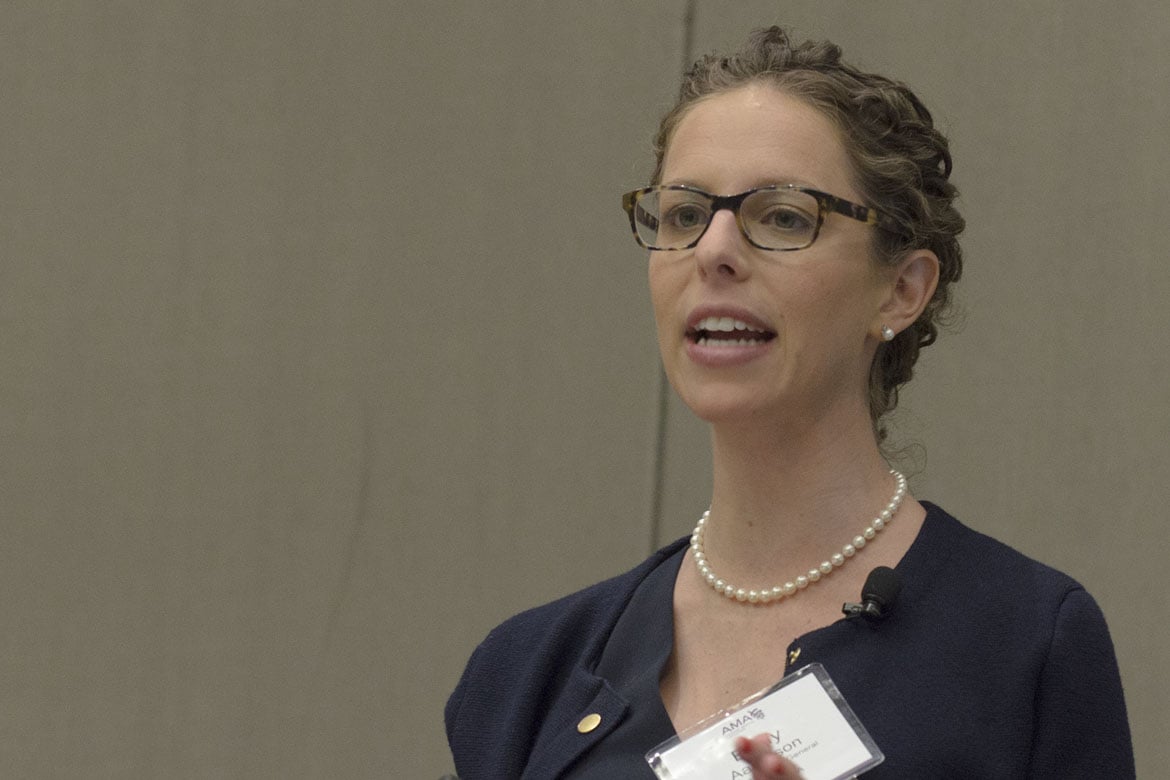There is an increased understanding that no matter the outcome, physicians are responsible for their patients. This places further importance on cultivating relationships with patients and understanding their needs through better communication.
At a recent education session, Emily Aaronson, MD, discussed how patient-physician communication improves care, decreases the risk of medical error and increases clinicians’ joy at work. Dr. Aaronson is an assistant professor of emergency medicine at Massachusetts General Hospital (MGH).
When Dr. Aaronson first started to dive into patient-centered communication as a fellow, she believed it mattered to patients and knew physicians weren’t getting enough formal training and could communicate better. However, she was not sure whether it mattered from a patient safety perspective.
“Did communication improve patient safety? Was it tied to outcomes?” Dr. Aaronson said. “The short story is that it absolutely is.” Effective communication leads to better health care outcomes, increased safety, improved adherence and more joy at work.
Half of inpatients don’t know their diagnosis
“In this world of patient-reported outcomes, it’s also important to think about what the patient’s perceptions of the drivers of quality health care are,” Dr. Aaronson said.
A patient’s perception of the quality of the health care they receive is highly dependent on the quality of the communication with their health care team. Though a single physician conducting as many as 200,000 patient interviews during her career, communication doesn’t get nearly as much “methodological training as so many other procedures that we do with far less frequency,” Dr. Aaronson said. “So it’s not particularly surprising that we’re not all that good at it.”
This lack of communication plays out in some alarming ways, Dr. Aaronson said during her presentation at the 2017 AMA Annual Meeting in Chicago.
“With less than 50 percent of hospitalized patients being able to identify their diagnosis or the names of their medications at discharge, it’s a clear failure in our ability to communicate with our patients about the plan of care,” she said.
Most visits lack core elements of patient-centered communication. One-third of adults with chronic illness underuse their prescriptions due to cost, while most patients and physicians disagree on the main problem 50 percent of the time, according to Dr. Aaronson.
Ineffective team communication has even been proven to be the root cause for nearly 66 percent of all medical errors, she said. Medical errors rise when the health care team is under stress in high-risk situations or when they are not communicating clearly.
There is also a strong correlation between concern physicians show for patients’ questions, the ability of physicians to clearly and effectively communicate information in a way that patients understand, how well physicians listen, and whether physicians are courteous and caring and patient safety. As patients perceive physicians and staff as more insightful and caring through better communication, outcomes also improve, Dr. Aaronson said.
Ties found among communication, empathy, joy
Team satisfaction has been getting a lot more attention as the focus on burnout proliferates. The evidence points to “the relationship between the clinician’s level of satisfaction and their ability to build rapport with their patients, their ability to express care and warmth [as] being critical in staving off burnout and cultivating joy in work,” Dr. Aaronson said.
In a study shared by Dr. Aaronson during the education session, physicians who participated in communication courses became more skilled and had improvements in empathy, which helped decrease burnout. And another study that looked at physicians who went through communication training showed less work-related stress and more joy at work.
At the practice level, physicians have higher proficiency and less burnout when providing increased communication with their patients.
Stress partly grows out of the circumstances in which physicians and their team members find themselves, amid ever-changing clinical guidelines and economic pressures. The good news, Dr. Aaronson said, is that these helpful communication techniques are highly teachable.
“We can train these skills,” she said.
Diagnostic accuracy, adherence to care
According to Dr. Aaronson, about 76 percent of diagnostic decisions can be made from history alone, but patients are only allowed to speak uninterrupted about a quarter of the time. Hearing what patients have to say will help physicians make the right diagnosis.
“We interrupt our patients all the time. We often behave in ways that communicate to our patients that what they’re saying is not important,” said Dr. Aaronson. “Patients will then fail to provide us with key pieces of information that could actually help us fit the diagnostic puzzle together..”
Unfortunately, about 25 percent of Americans report they are not following their physicians’ advice, Dr. Aaronson said. One-fourth of these patients said that was because the instructions were too difficult to follow. Dr. Aaronson went on to state that it isn’t a surprise that patients are not following their regimens. Better attention to medication adherence and improved self-management occurs with better communication.
But how can physicians communicate effectively? Dr. Aaronson shared the “ICARE” method, which proceeds as follows:
- Introduce: State your name and role in the patient’s care, and sit and make eye contact.
- Collaborate: Encourage patients to continue.
- Acknowledge: The emotion, patient and situation.
- Reflectively listen: Let the patient speak and invite them to speak.
- Set Expectations: Communicate about the plan of care and uncertainty.
Patient-physician communication is teachable with simple, high-yield tactics found in the medical literature. Institutions should be thoughtfully designing effective programs to educate their clinical staff on communication, Dr. Aaronson said.
An increase in patient-centered communication “has been correlated with better recovery from discomfort, better resolution of the primary concern, better emotional health—all really in the primary care setting,” she said.




